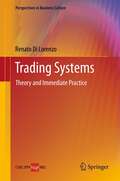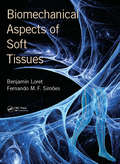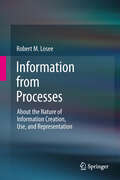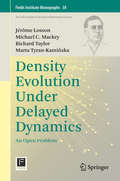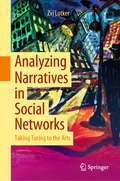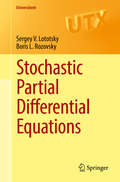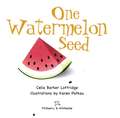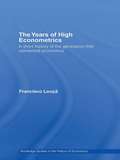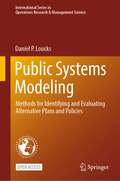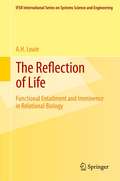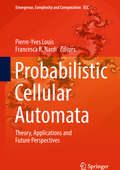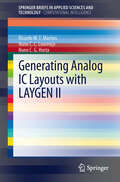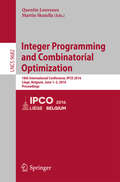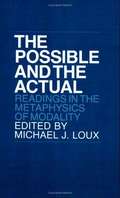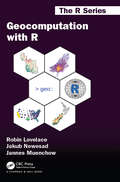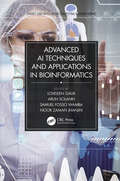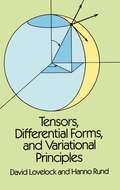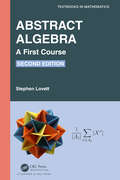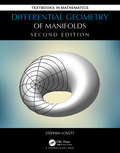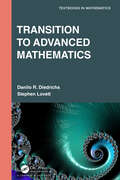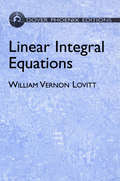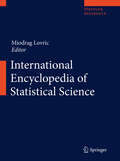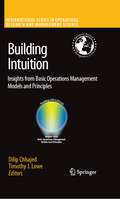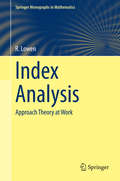- Table View
- List View
Trading Systems
by Renato Di LorenzoFor years, systems theory has been applied successfully in all fields of technology, but its impact on the world of finance has to date been limited. This book aims to rectify this situation. Readers will no longer be able to assert that money cannot be reliably earned on the financial markets: one might just as well say that man has never set foot on the moon. The potential reader may be frightened by the number of formulas, but can be reassured that almost all of them can be skipped. What makes the miracle of guaranteed trading success possible are the worksheets and the codes for Internet platforms which provide (at a click) functions that once had to be built with great difficulty. These worksheets and codes will be sent free of charge to anyone who requests them from the author (renato.dilorenzo1@gmail.com) as long as the request is accompanied by proof of purchase of the book, such as a photograph of the receipt taken on a mobile phone.
Biomechanical Aspects of Soft Tissues
by Benjamin Loret Fernando Manuel SimoesBiomechanics applies the laws and techniques of mechanics in the study of biological systems and related phenomena. Biomechanics uses mathematical and computational tools such as model construction of musclo-skeletal system, body fluid circulation, to aid medical diagnosis, therapeutics and surgery planning, designing of prostheses and implants or in tissue engineering. Present book targets specific topics pertaining to the biomechanics of soft tissues. Subjects addressed includes solids and multi-species mixtures as open systems: a continuum mechanics perspective; electro-chemo-mechanical couplings: tissues with a fixed electric charge and growth of biological tissues.
Information from Processes
by Robert M. LoseeInformation is an important concept that is studied extensively across a range of disciplines, from the physical sciences to genetics to psychology to epistemology. Information continues to increase in importance, and the present age has been referred to as the "Information Age." One may understand information in a variety of ways. For some, information is found in facts that were previously unknown. For others, a fact must have some economic value to be considered information. Other people emphasize the movement through a communication channel from one location to another when describing information. In all of these instances, information is the set of characteristics of the output of a process. Yet Information has seldom been studied in a consistent way across different disciplines. Information from Processes provides a discipline-independent and precise presentation of both information and computing processes. Information concepts and phenomena are examined in an effort to understand them, given a hierarchy of information processes, where one process uses others. Research about processes and computing is applied to answer the question of what information can and cannot be produced, and to determine the nature of this information (theoretical information science). The book also presents some of the basic processes that are used in specific domains (applied information science), such as those that generate information in areas like reasoning, the evolution of informative systems, cryptography, knowledge, natural language, and the economic value of information. Written for researchers and graduate students in information science and related fields, Information from Processes details a unique information model independent from other concepts in computer or archival science, which is thus applicable to a wide range of domains. Combining theoretical and empirical methods as well as psychological, mathematical, philosophical, and economic techniques, Losee's book delivers a solid basis and starting point for future discussions and research about the creation and use of information.
Density Evolution Under Delayed Dynamics: An Open Problem (Fields Institute Monographs #38)
by Jérôme Losson Michael C. Mackey Richard Taylor Marta Tyran-KamińskaThis monograph has arisen out of a number of attempts spanning almost five decades to understand how one might examine the evolution of densities in systems whose dynamics are described by differential delay equations. Though the authors have no definitive solution to the problem, they offer this contribution in an attempt to define the problem as they see it, and to sketch out several obvious attempts that have been suggested to solve the problem and which seem to have failed. They hope that by being available to the general mathematical community, they will inspire others to consider–and hopefully solve–the problem. Serious attempts have been made by all of the authors over the years and they have made reference to these where appropriate.
Analyzing Narratives in Social Networks: Taking Turing to the Arts
by Zvi LotkerThis book uses literature as a wrench to pry open social networks and to ask different questions than have been asked about social networks previously. The book emphasizes the story-telling aspect of social networks, as well as the connection between narrative and social networks by incorporating narrative, dynamic networks, and time. Thus, it constructs a bridge between literature, digital humanities, and social networks. This book is a pioneering work that attempts to express social and philosophic constructs in mathematical terms.The material used to test the algorithms is texts intended for performance, such as plays, film scripts, and radio plays; mathematical representations of the texts, or “literature networks”, are then used to analyze the social networks found in the respective texts. By using literature networks and their accompanying narratives, along with their supporting analyses, this book allows for a novel approach to social network analysis.
Stochastic Partial Differential Equations
by Sergey V. Lototsky Boris L. RozovskyTaking readers with a basic knowledge of probability and real analysis to the frontiers of a very active research discipline, this textbook provides all the necessary background from functional analysis and the theory of PDEs. It covers the main types of equations (elliptic, hyperbolic and parabolic) and discusses different types of random forcing. The objective is to give the reader the necessary tools to understand the proofs of existing theorems about SPDEs (from other sources) and perhaps even to formulate and prove a few new ones. Most of the material could be covered in about 40 hours of lectures, as long as not too much time is spent on the general discussion of stochastic analysis in infinite dimensions. As the subject of SPDEs is currently making the transition from the research level to that of a graduate or even undergraduate course, the book attempts to present enough exercise material to fill potential exams and homework assignments. Exercises appear throughout and are usually directly connected to the material discussed at a particular place in the text. The questions usually ask to verify something, so that the reader already knows the answer and, if pressed for time, can move on. Accordingly, no solutions are provided, but there are often hints on how to proceed. The book will be of interest to everybody working in the area of stochastic analysis, from beginning graduate students to experts in the field.
One Watermelon Seed
by Celia Barker LottridgeIn this deceptively simple counting book, Max and Josephine tend their garden while readers follow along, counting from one to ten as the garden is planted. Then readers can count in groups of tens as the garden is harvested, while they search through the pictures for the many small animals that are hiding throughout. A concise and clever text introduces color and rhythm, and the illustrations are bright and engaging, making this a perfect counting book for children aged four to seven.
The Years of High Econometrics: A Short History of the Generation that Reinvented Economics (Routledge Studies in the History of Economics)
by Francisco LouçãA fascinating and comprehensive history, this book explores the most important transformation in twentieth century economics: the creation of econometrics. Containing fresh archival material that has not been published before and taking Ragnar Frisch as the narrator, Francisco Louca discusses both the keys events - the establishment of the Econometric Society, the Cowles Commission and the journal Econometrica – and the major players - economists like Wesley Mitchell, mathematicians like John von Neumann and statisticians like Karl Pearson - in history that shaped the development of econometrics. He discusses the evolution of their thought, detailing the debates, the quarrels and the interrogations that crystallized their work and even offers a conclusion of sorts, suggesting that some of the more influential thinkers abandoned econometrics or became critical of its development. International in scope and appeal, The Years of High Econometrics is an excellent accompaniment for students taking courses on probability, econometric methods and the history of economic thought.
Public Systems Modeling: Methods for Identifying and Evaluating Alternative Plans and Policies (International Series in Operations Research & Management Science #318)
by Daniel P. LoucksThis is an open access book discusses readers to various methods of modeling plans and policies that address public sector issues and problems. Written for public policy and social sciences students at the upper undergraduate and graduate level, as well as public sector decision-makers, it demonstrates and compares the development and use of various deterministic and probabilistic optimization and simulation modeling methods for analyzing planning and management issues. These modeling tools offer a means of identifying and evaluating alternative plans and policies based on their physical, economic, environmental, and social impacts. Learning how to develop and use the mathematical modeling tools introduced in this book will give students useful skills when in positions of having to make informed public policy recommendations or decisions.
The Reflection of Life
by A. H. LouieA. H. Louie's The Reflection of Life: Functional Entailment and Imminence in Relational Biology is a continuation of the exploratory journey in relational biology which began with his 2009 monograph More Than Life Itself: A Synthetic Continuation in Relational Biology. The theme of his first book was 'What is life?'; the theme of this sequel is "How do two life forms interact?" Biology is a subject concerned with organization of relations. Relational biology is the approach that advocates 'function dictates structure", rather than 'structure implies function'. It is mathematics decoded into biological realizations. The book demonstrates some of the powers of the approach of relational biology, and illustrates how pertinent problems in biology can be better addressed this way. In the first volume the theory was developed by using partially ordered sets, lattices, simulations, models, Aristotle's four causes, graphs, categories, simple and complex systems, anticipatory systems, and metabolism-repair [(M,R)-] systems. Here in the second volume, these tools are expanded to employ set-valued mappings, adjacency matrices, random graphs, and interacting entailment networks. The theory of set-valued mappings culminates in the imminence mapping, which equips the further investigation of functional entailment in complex relational networks. Imminence in (M,R)-networks that model living systems addresses the topics of biogenesis and natural selection. Interacting (M,R)-networks with mutually entailing processes serve as models in the study of symbiosis and pathophysiology. The formalism also provides a natural framework for a relational theory of virology and oncology. This book will serve researchers and graduate students in mathematics and biology.
Probabilistic Cellular Automata: Theory, Applications And Future Perspectives (Emergence, Complexity And Computation Ser. #27)
by Pierre-Yves Louis Francesca R. NardiThis book explores Probabilistic Cellular Automata (PCA) from the perspectives of statistical mechanics, probability theory, computational biology and computer science. PCA are extensions of the well-known Cellular Automata models of complex systems, characterized by random updating rules. Thanks to their probabilistic component, PCA offer flexible computing tools for complex numerical constructions, and realistic simulation tools for phenomena driven by interactions among a large number of neighboring structures. PCA are currently being used in various fields, ranging from pure probability to the social sciences and including a wealth of scientific and technological applications. This situation has produced a highly diversified pool of theoreticians, developers and practitioners whose interaction is highly desirable but can be hampered by differences in jargon and focus. This book – just as the workshop on which it is based – is an attempt to overcome these difference and foster interest among newcomers and interaction between practitioners from different fields. It is not intended as a treatise, but rather as a gentle introduction to the role and relevance of PCA technology, illustrated with a number of applications in probability, statistical mechanics, computer science, the natural sciences and dynamical systems. As such, it will be of interest to students and non-specialists looking to enter the field and to explore its challenges and open issues.
Generating Analog IC Layouts with LAYGEN II
by Nuno C. Lourenço Ricardo M. Martins Nuno C.G. HortaThis book presents an innovative methodology for the automatic generation of analog integrated circuits (ICs) layout, based on template descriptions and on evolutionary computational techniques. A design automation tool, LAYGEN II was implemented to validate the proposed approach giving special emphasis to reusability of expert design knowledge and to efficiency on retargeting operations.
Integer Programming and Combinatorial Optimization
by Quentin Louveaux Martin SkutellaThis book constitutes therefereed proceedings of the 18th International Conference on IntegerProgramming and Combinatorial Optimization, IPCO 2016, held in Liège, Belgium,in June 2016. The 33 full papers presented were carefully reviewed and selectedfrom 125 submissions. The conference is a forum for researchers andpractitioners working on various aspects of integer programming andcombinatorial optimization. The aim is to present recent developments intheory, computation, and applications in these areas. The scope of IPCO isviewed in a broad sense, to include algorithmic and structural results ininteger programming and combinatorial optimization as well as revealingcomputational studies and novel applications of discrete optimization topractical problems.
The Possible and the Actual: Readings in the Metaphysics of Modality
by Michael J. LouxThis well-chosen collection of fifteen important essays in the fields of philosophical logic and metaphysics addresses questions relating to the nature and status of possible worlds.
Spatial Microsimulation with R (Chapman & Hall/CRC The R Series)
by Robin Lovelace Morgane DumontGenerate and Analyze Multi-Level Data Spatial microsimulation involves the generation, analysis, and modeling of individual-level data allocated to geographical zones. Spatial Microsimulation with R is the first practical book to illustrate this approach in a modern statistical programming language. Get Insight into Complex BehaviorsThe book progresses from the principles underlying population synthesis toward more complex issues such as household allocation and using the results of spatial microsimulation for agent-based modeling. This equips you with the skills needed to apply the techniques to real-world situations. The book demonstrates methods for population synthesis by combining individual and geographically aggregated datasets using the recent R packages ipfp and mipfp. This approach represents the "best of both worlds" in terms of spatial resolution and person-level detail, overcoming issues of data confidentiality and reproducibility. Implement the Methods on Your Own DataFull of reproducible examples using code and data, the book is suitable for students and applied researchers in health, economics, transport, geography, and other fields that require individual-level data allocated to small geographic zones. By explaining how to use tools for modeling phenomena that vary over space, the book enhances your knowledge of complex systems and empowers you to provide evidence-based policy guidance.
Geocomputation with R (Chapman & Hall/CRC The R Series)
by Robin Lovelace Jakub Nowosad Jannes MuenchowGeocomputation with R is for people who want to analyze, visualize and model geographic data with open source software. It is based on R, a statistical programming language that has powerful data processing, visualization, and geospatial capabilities. The book equips you with the knowledge and skills to tackle a wide range of issues manifested in geographic data, including those with scientific, societal, and environmental implications. This book will interest people from many backgrounds, especially Geographic Information Systems (GIS) users interested in applying their domain-specific knowledge in a powerful open source language for data science, and R users interested in extending their skills to handle spatial data. The book is divided into three parts: (I) Foundations, aimed at getting you up-to-speed with geographic data in R, (II) extensions, which covers advanced techniques, and (III) applications to real-world problems. The chapters cover progressively more advanced topics, with early chapters providing strong foundations on which the later chapters build. Part I describes the nature of spatial datasets in R and methods for manipulating them. It also covers geographic data import/export and transforming coordinate reference systems. Part II represents methods that build on these foundations. It covers advanced map making (including web mapping), "bridges" to GIS, sharing reproducible code, and how to do cross-validation in the presence of spatial autocorrelation. Part III applies the knowledge gained to tackle real-world problems, including representing and modeling transport systems, finding optimal locations for stores or services, and ecological modeling. Exercises at the end of each chapter give you the skills needed to tackle a range of geospatial problems. Solutions for each chapter and supplementary materials providing extended examples are available at https://geocompr.github.io/geocompkg/articles/.
Advanced AI Techniques and Applications in Bioinformatics (Smart and Intelligent Computing in Engineering)
by Loveleen Gaur, Arun Solanki, Samuel Fosso Wamba and Noor Zaman JhanjhiThe advanced AI techniques are essential for resolving various problematic aspects emerging in the field of bioinformatics. This book covers the recent approaches in artificial intelligence and machine learning methods and their applications in Genome and Gene editing, cancer drug discovery classification, and the protein folding algorithms among others. Deep learning, which is widely used in image processing, is also applicable in bioinformatics as one of the most popular artificial intelligence approaches. The wide range of applications discussed in this book are an indispensable resource for computer scientists, engineers, biologists, mathematicians, physicians, and medical informaticists. Features: Focusses on the cross-disciplinary relation between computer science and biology and the role of machine learning methods in resolving complex problems in bioinformatics Provides a comprehensive and balanced blend of topics and applications using various advanced algorithms Presents cutting-edge research methodologies in the area of AI methods when applied to bioinformatics and innovative solutions Discusses the AI/ML techniques, their use, and their potential for use in common and future bioinformatics applications Includes recent achievements in AI and bioinformatics contributed by a global team of researchers
Tensors, Differential Forms, and Variational Principles
by David Lovelock Hanno RundIncisive, self-contained account of tensor analysis and the calculus of exterior differential forms, interaction between the concept of invariance and the calculus of variations. Emphasis is on analytical techniques, with large number of problems, from routine manipulative exercises to technically difficult assignments.
Abstract Algebra: A First Course (Textbooks in Mathematics)
by Stephen LovettWhen a student of mathematics studies abstract algebra, he or she inevitably faces questions in the vein of, "What is abstract algebra" or "What makes it abstract?" Algebra, in its broadest sense, describes a way of thinking about classes of sets equipped with binary operations. In high school algebra, a student explores properties of operations (+, −, ×, and ÷) on real numbers. Abstract algebra studies properties of operations without specifying what types of number or object we work with. Any theorem established in the abstract context holds not only for real numbers but for every possible algebraic structure that has operations with the stated properties. This textbook intends to serve as a first course in abstract algebra. The selection of topics serves both of the common trends in such a course: a balanced introduction to groups, rings, and fields; or a course that primarily emphasizes group theory. The writing style is student-centered, conscientiously motivating definitions and offering many illustrative examples. Various sections or sometimes just examples or exercises introduce applications to geometry, number theory, cryptography and many other areas. This book offers a unique feature in the lists of projects at the end of each section. the author does not view projects as just something extra or cute, but rather an opportunity for a student to work on and demonstrate their potential for open-ended investigation. The projects ideas come in two flavors: investigative or expository. The investigative projects briefly present a topic and posed open-ended questions that invite the student to explore the topic, asking and to trying to answer their own questions. Expository projects invite the student to explore a topic with algebraic content or pertain to a particular mathematician’s work through responsible research. The exercises challenge the student to prove new results using the theorems presented in the text. The student then becomes an active participant in the development of the field.
Differential Geometry of Manifolds (Textbooks in Mathematics)
by Stephen LovettDifferential Geometry of Manifolds, Second Edition presents the extension of differential geometry from curves and surfaces to manifolds in general. The book provides a broad introduction to the field of differentiable and Riemannian manifolds, tying together classical and modern formulations. It introduces manifolds in a both streamlined and mathematically rigorous way while keeping a view toward applications, particularly in physics. The author takes a practical approach, containing extensive exercises and focusing on applications, including the Hamiltonian formulations of mechanics, electromagnetism, string theory. The Second Edition of this successful textbook offers several notable points of revision. New to the Second Edition: New problems have been added and the level of challenge has been changed to the exercises Each section corresponds to a 60-minute lecture period, making it more user-friendly for lecturers Includes new sections which provide more comprehensive coverage of topics Features a new chapter on Multilinear Algebra
Transition to Advanced Mathematics (Textbooks in Mathematics)
by Stephen Lovett Danilo R. DiedrichsThis unique and contemporary text not only offers an introduction to proofs with a view towards algebra and analysis, a standard fare for a transition course, but also presents practical skills for upper-level mathematics coursework and exposes undergraduate students to the context and culture of contemporary mathematics. The authors implement the practice recommended by the Committee on the Undergraduate Program in Mathematics (CUPM) curriculum guide, that a modern mathematics program should include cognitive goals and offer a broad perspective of the discipline. Part I offers: An introduction to logic and set theory. Proof methods as a vehicle leading to topics useful for analysis, topology, algebra, and probability. Many illustrated examples, often drawing on what students already know, that minimize conversation about "doing proofs." An appendix that provides an annotated rubric with feedback codes for assessing proof writing. Part II presents the context and culture aspects of the transition experience, including: 21st century mathematics, including the current mathematical culture, vocations, and careers. History and philosophical issues in mathematics. Approaching, reading, and learning from journal articles and other primary sources. Mathematical writing and typesetting in LaTeX. Together, these Parts provide a complete introduction to modern mathematics, both in content and practice. Table of Contents Part I - Introduction to Proofs Logic and Sets Arguments and Proofs Functions Properties of the Integers Counting and Combinatorial Arguments RelationsPart II - Culture, History, Reading, and Writing Mathematical Culture, Vocation, and Careers History and Philosophy of Mathematics Reading and Researching Mathematics Writing and Presenting Mathematics Appendix A. Rubric for Assessing Proofs Appendix B. Index of Theorems and Definitions from Calculus and Linear Algebra Bibliography Index Biographies Danilo R. Diedrichs is an Associate Professor of Mathematics at Wheaton College in Illinois. Raised and educated in Switzerland, he holds a PhD in applied mathematical and computational sciences from the University of Iowa, as well as a master’s degree in civil engineering from the Ecole Polytechnique Fédérale in Lausanne, Switzerland. His research interests are in dynamical systems modeling applied to biology, ecology, and epidemiology. Stephen Lovett is a Professor of Mathematics at Wheaton College in Illinois. He holds a PhD in representation theory from Northeastern University. His other books include Abstract Algebra: Structures and Applications (2015), Differential Geometry of Curves and Surfaces, with Tom Banchoff (2016), and Differential Geometry of Manifolds (2019).
Linear Integral Equations
by William Vernon LovittReadable and systematic, this volume offers coherent presentations of not only the general theory of linear equations with a single integration, but also of applications to differential equations, the calculus of variations, and special areas in mathematical physics. Topics include the solution of Fredholm's equation expressed as a ratio of two integral series in lambda, free and constrained vibrations of an elastic string, and auxiliary theorems on harmonic functions. Discussion of the Hilbert-Schmidt theory covers boundary problems for ordinary linear differential equations, vibration problems, and flow of heat in a bar. 1924 edition.
International Encyclopedia of Statistical Science
by Miodrag LovricThe goal of this book is multidimensional: a) to help reviving Statistics education in many parts in the world where it is in crisis. For the first time authors from many developing countries have an opportunity to write together with the most prominent world authorities. The editor has spent several years searching for the most reputable statisticians all over the world. International contributors are either presidents of the local statistical societies, or head of the Statistics department at the main university, or the most distinguished statisticians in their countries. b) to enable any non-statistician to obtain quick and yet comprehensive and highly understandable view on certain statistical term, method or application c) to enable all the researchers, managers and practicioners to refresh their knowledge in Statistics, especially in certain controversial fields. d) to revive interest in statistics among students, since they will see its usefulness and relevance in almost all branches of Science.
Building Intuition: Insights from Basic Operations Management Models and Principles (International Series in Operations Research & Management Science #115)
by Timothy J. Lowe Dilip ChhajedThis is the first book in the field that uses the power of the basic models and principles to provide students and managers with an "intuitive understanding" of operations management. The book touches on nine fundamental models and principles, and outlines the key insights behind each one. Some of the very biggest names in the Management Science field have developed and carefully written these chapters on the field's basic models.
Index Analysis
by R. LowenThe featured review of the AMS describes the author's earlier work in the field of approach spaces as, 'A landmark in the history of general topology'. In this book, the author has expanded this study further and taken it in a new and exciting direction. The number of conceptually and technically different systems which characterize approach spaces is increased and moreover their uniform counterpart, uniform gauge spaces, is put into the picture. An extensive study of completions, both for approach spaces and for uniform gauge spaces, as well as compactifications for approach spaces is performed. A paradigm shift is created by the new concept of index analysis. Making use of the rich intrinsic quantitative information present in approach structures, a technique is developed whereby indices are defined that measure the extent to which properties hold, and theorems become inequalities involving indices; therefore vastly extending the realm of applicability of many classical results. The theory is then illustrated in such varied fields as topology, functional analysis, probability theory, hyperspace theory and domain theory. Finally a comprehensive analysis is made concerning the categorical aspects of the theory and its links with other topological categories. Index Analysis will be useful for mathematicians working in category theory, topology, probability and statistics, functional analysis, and theoretical computer science.
